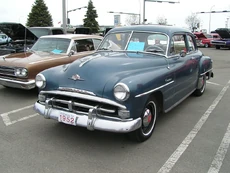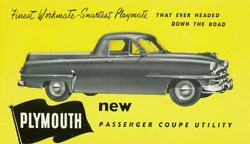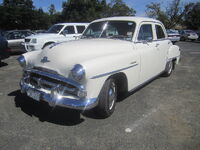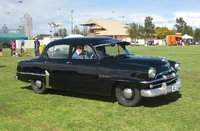 1952 Plymouth Cranbrook Club Coupe | |
| Manufacturer | Plymouth (Chrysler) |
|---|---|
| Production | 1951–1953 |
| Assembly |
Lynch Road Assembly, Highland Park, MI, United States Australia [1] |
| Predecessor | Plymouth Special Deluxe |
| Successor | Plymouth Belvedere |
| Class | Full-size |
| Body style(s) |
4-door sedan 2-door coupe 2-door hardtop coupe 2-door convertible 3-door wagon [2] 2-door coupe utility (Australia) |
| Engine(s) | 3.6 L Flathead I6 |
| Wheelbase |
1951-52: 118.5 in (3,010 mm) 1953: 114 in (2,896 mm) |
| Length |
1951-52: 193.875 in (4,924 mm) 1953: 189.125 in (4,804 mm) |
| Related |
Dodge Meadowbrook Plymouth Concord Plymouth Cambridge |
The Plymouth Cranbrook is an automobile which was built by Plymouth from 1951 to 1953. It replaced the Special Deluxe when Plymouth changed its naming scheme and was essentially the same as the Plymouth Concord and Cambridge, but at a higher trim level.
The name Cranbrook may have been taken from a city in British Columbia, but it may also have been taken from Cranbrook Drive in Detroit; this small street intersected with Cambridge Avenue. Both streets are between 7 Mile Road West and 8 Mile Road West, near the Dodge Main plant. Concord Street ran by the plant. This indicates that the cars may have been named after streets near Chrysler Corporation facilities.
1951 - 1952 (P-23 series)[]
The Plymouth Cranbrook, as a car, was conservatively styled, designed to fit K.T. Keller's notion that cars be practical and allow drivers to sit upright while wearing a hat; it was sold at a time when competitors favored the low and sleek look. Differences between the 1950 Special Deluxe and the 1951 Plymouth Cranbrook are relatively few in number and scope, with interchangeable glass and doors, but different rubber seals; lack of woodgrain on the instrument panel; plastic brake handle instead of chrome; and other similar changes. More substantial was having what had been the hood release handle function as the overdrive control. Fender lettering and other badging necessarily changed as well. From a distance, the cars were essentially similar.
The Plymouth Cambridge and Plymouth Cranbrook models shared the P-23 Series Number in both 1951 and 1952.[3] The six-cylinder flathead engine produced 97 hp (72 kW).
1953 (P-24 series)[]

1953 Plymouth Cranbrook Convertible Club Coupe
For 1953, the boxy shape was changed for straighter lines, with sleeker and more modern styling. The windshield went to a modern one-piece unit; and the door handles pulled out instead of twisting. The glove box was moved to the center for easier access by the driver. The gas cap was moved to under the trunk lid, resulting in initial problems with gas spilling out of a full tank into the trunk; this problem was resolved with baffles in mid-1953.
The three-window coupe and fastback sedan were dropped for 1953; the former long and short wheelbase models were consolidated with a common wheelbase of 114 inches (2,900 mm), only one inch shorter than those of Chevrolet and Ford (though considerably less overhang than those competitors gave the Cranbrook a "shorter" look.) Power increased margnially, to 100 hp (75 kW).
The 1953 Plymouth Cranbrook was designated Series P-24-2 and the lower trim level Cambridge was the P-24-1.[4]
In 1954, the Cranbrook name was replaced by the Belvedere, which had been the top trim level of the Cranbrook; all Plymouth names were switched to those of upscale hotels.
Australian production[]
The Plymouth P-23 series was also produced in Australia [5] and was marketed under the Cranbrook name.[6] 4,382 examples were built in the years 1951 to 1953.[5]
The Plymouth P-24 series, which was marketed in the U.S. as the 1953 Plymouth,[4] was also assembled in Australia in that year by Chrysler Australia.[7] As in the U.S.,[4] it was sold as the Plymouth Cambridge and Cranbrook.[1]

Plymouth Cranbrook Coupe Utility
In 1954 assembly of the P-25 series commenced, with Plymouth Cambridge, Cranbrook, Savoy and Belvedere names used.[8] Australian design input was minimal, although major body panels were locally produced. From 1956 a coupe utility variant was offered in addition to the four door sedan and was available in Cranbrook, Savoy and Belvedere models.[9] Australian production of the P-25 continued through to 1957.[8]
References[]
- ↑ 1.0 1.1 Gavin Farmer, Great Ideas in Motion, A History of Chrysler in Australia, 2010, page 17
- ↑ Fold-out sales brochure for the 1953 Plymouth, paintref.com Retrieved on 27 January 2015
- ↑ John Gunnell, Standard Catalog of American Cars 1946-1975, Revised 4th Edition, pages 646-649
- ↑ 4.0 4.1 4.2 John Gunnell, Standard Catalog of American Cars 1946-1975, Revised 4th Edition, page 649
- ↑ 5.0 5.1 Gavin Farmer, Great Ideas In Motion, A History of Chrysler in Australia, 2010, pages 405-406
- ↑ Statistics of motor cars sold in Australia from 1923 to 1957, Restored Cars (magazine) No 21, page 20
- ↑ Gavin Farmer, Great Ideas in Motion, A History of Chrysler in Australia, 2010, page 407
- ↑ 8.0 8.1 Gavin Farmer, Great Ideas in Motion, A History of Chrysler in Australia, 2010, pages 23 to 25
- ↑ My UTEs!, www.roadkillontheweb.com Retrieved on 13 February 2013
- Gunnell, John (Editor): Standard Catalog of American Cars 1946-1975, Krause Publications Inc., Iola (2002),
This 0-87349-461-X lacks ISBNs for the books listed in it. Please make it easier to conduct research by listing ISBNs. If the {{Cite book}} or {{citation}} templates are in use, you may add ISBNs automatically, or discuss this issue on the talk page. External links[]
- http://www.allpar.com/history/plymouth/plymouths-1949-1952.html
- http://www.allpar.com/old/plymouth/plymouth-1953-54.html
- 1952 Plymouth Utility at allcarcentral.com
Historic CarsAcclaim • Arrow • Barracuda • Belvedere • Breeze • Cambridge • Caravelle • Champ • Colt • Concord • Conquest • Cranbrook • Cricket (North America, Canada) • Deluxe • Duster • Fury • Gran Fury • GTX • Horizon • Laser • Neon • Plaza • Prowler • Reliant • Road Runner • Sapporo • Satellite • Savoy • Special Deluxe • Sundance • Superbird • TC3 • Turismo • Valiant • VIP • VolaréConcept Cars
This page uses some content from Wikipedia. The original article was at Plymouth Cranbrook. The list of authors can be seen in the page history. As with Tractor & Construction Plant Wiki, the text of Wikipedia is available under the Creative Commons by Attribution License and/or GNU Free Documentation License. Please check page history for when the original article was copied to Wikia
Plymouth road car timeline, 1950–1970s, United States market — next » Type 1950s 1960s 1970s 0 1 2 3 4 5 6 7 8 9 0 1 2 3 4 5 6 7 8 9 0 1 2 3 4 5 6 7 8 9 Subcompact Cricket Horizon Horizon TC3 Colt Compact Colt Arrow Valiant Volaré Mid-size Belvedere Satellite Fury Full-size Deluxe Concord Plaza Cambridge Savoy Special Deluxe Cranbrook Belvedere Fury Fury Fury Fury Fury Gran Fury Sports Duster Sapporo Barracuda Road Runner Road Runner Road Runner GTX SUV Trailduster Van Voyager

